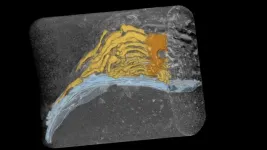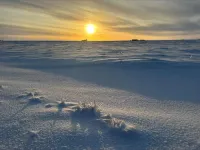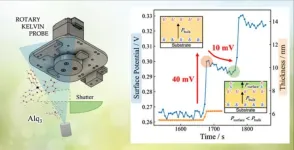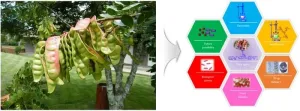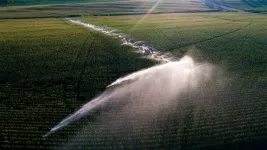(Press-News.org) Climate change is reshaping forests differently across the United States, according to a new analysis of U.S. Forest Service data. With rising temperatures, escalating droughts, wildfires, and disease outbreaks taking a toll on trees, researchers warn that forests across the American West are bearing the brunt of the consequences.
The study, led by UF Biology researchers J. Aaron Hogan and Jeremy W. Lichstein was published in the Proceedings of the National Academy of Sciences. The study reveals a pronounced regional imbalance in forest productivity, a key barometer of forest health that gauges tree growth and biomass accumulation. Over the past two decades, the Western U.S., grappling with more severe climate change impacts, has exhibited a notable slowdown in productivity, while the Eastern U.S., experiencing milder climate effects, has seen slightly accelerated growth.
Forests play a critical role in regulating the Earth’s climate, acting as carbon sinks that sequester approximately 25% of human carbon emissions annually. However, their ability to store carbon hinges on the delicate balance between the positive and negative effects of climate change. The study, using national-scale forest inventory data, models trends from 1999 to 2020, analyzing 113,806 measurements in non-plantation forests.
“We are witnessing changes in forest functioning as forest ecosystems respond to global change drivers, such as carbon-dioxide-fertilization and climate change,” said Hogan. “It is the future balance of these drivers which will determine the functioning of forests in the coming years to decades.”
Some drivers, such as droughts and forest pathogens, have negative effects on productivity, but other drivers, such as carbon-dioxide fertilization, are predicted to have positive effects. This phenomenon suggests that increased carbon-dioxide levels enhance plant growth by increasing photosynthesis, which inspired the researchers to take a deeper look at its impact.
“The U.S. Forest Service has been monitoring the growth and survival of over a million trees across the U.S. for multiple decades,” said Lichstein. “We were interested to see if their data provided evidence for increased rates of tree growth, as predicted by the carbon-dioxide fertilization hypothesis.”
While tree growth in the Eastern U.S. aligns with expectations, the Western region shows extreme climate effects overshadowing any positive growth trends, challenging the prevailing assumption that forests’ carbon-storing ability will continue to increase.
“Our study suggests that future projections of climate and sea-level rise may be too optimistic because, in reality, ecosystems are likely to store less carbon in the future,” said Lichstein. “Less ecosystem carbon storage means more carbon in the atmosphere and therefore more warming and accelerating climate change.”
The findings also illuminate the fact that climate change is not a uniform force but rather a dynamic agent with region-specific influences. The study illustrates how the degree of climate change can push forests past a tipping point. Some forests are already approaching or surpassing climate thresholds which shift them to become sources of carbon, rather than sinks that remove carbon from the atmosphere.
“Ecosystem carbon sequestration is not guaranteed to be permanent, and it can be reversed by climate change,” said Lichstein. “This reversal is already happening in the Western U.S., and there are signs that it may also be happening in other drought-impacted regions of the world, such as the Amazon.”
It might be tempting to chalk the losses up to extreme events. But, according to the researchers, the decline in productivity in the Western U.S. cannot be attributed to increased rates of tree mortality.
“We hear a lot about wildfires in the Western U.S., which kill a lot of trees and release carbon to the atmosphere,” said Lichstein. “But our study shows that additional ecosystem carbon loss in Western forests is occurring due to declining tree growth rates.”
With trees growing slower due to adverse climate change effects, including decreased precipitation, the study implies that, even without the intensifying wildfires, the carbon sink in Western forests will continue to weaken without urgent action to reduce human greenhouse gas emissions.
“We must have healthy forests in connection with emissions reduction to restore the global carbon balance and limit climate change,” said Hogan.
The transformations observed in U.S. forests raise concerns about their future resilience and sustainability. The researchers hope their findings highlight the urgent need for governments and industry to work together to reduce greenhouse gas emissions and achieve net-zero emissions as soon as possible.
“Our results highlight the need for reduced global greenhouse gas emissions,” said Lichstein. “Without the emissions reductions that scientists have been urging for decades, forest carbon sinks will likely weaken, which will accelerate the pace of climate change.”
This study was developed with Grant Domke from the U.S. Forest Service Northern Research Station, Kai Zhu from the University of Michigan, and Dan Johnson from UF’s School of Forest, Fisheries, and Geomatics Sciences.
END
Climate change threatens global forest carbon sequestration, study finds
2024-01-15
ELSE PRESS RELEASES FROM THIS DATE:
Pacific kelp forests are far older that we thought
2024-01-15
The unique underwater kelp forests that line the Pacific Coast support a varied ecosystem that was thought to have evolved along with the kelp over the past 14 million years.
But a new study shows that kelp flourished off the Northwest Coast more than 32 million years ago, long before the appearance of modern groups of marine mammals, sea urchins, birds and bivalves that today call the forests home.
The much greater age of these coastal kelp forests, which today are a rich ecosystem supporting otters, sea lions, seals, and many birds, fish and crustaceans, means that they likely were a ...
Erectile dysfunction medications may increase risk of death when combined with common chest pain medication
2024-01-15
Phosphodiesterase type 5 inhibitors (PDE5i)—an erectile dysfunction drug sold under the names Viagra, Levitra, Cialis, and others—are a common medical treatment for erectile dysfunction (ED) in men with cardiovascular disease (CVD). However, a new Swedish study published today in the Journal of the American College of Cardiology suggests that patients are at higher risk for morbidity and mortality over time when PDE5is and nitrate medication are both prescribed.
Erectile dysfunction is a common condition in middle-aged and older men and is a strong predictor of coronary ...
Key moment in the evolution of life on Earth captured in fossils
2024-01-15
Curtin-led research has for the first time precisely dated some of the oldest fossils of complex multicellular life in the world, helping to track a pivotal moment in the history of Earth when the seas began teeming with new lifeforms - after four billion years of containing only single-celled microbes.
Lead author PhD student Anthony Clarke, from the Timescales of Mineral Systems Group within Curtin’s School of Earth and Planetary Sciences, said to determine the age of the fossils, researchers used volcanic ash layers like bookmarks in the geological sequence.
“Located ...
Chasing the light: Sandia study finds new clues about warming in the Arctic
2024-01-15
ALBUQUERQUE, N.M. — The Arctic, Earth’s icy crown, is experiencing a climate crisis like no other. It’s heating up at a furious pace — four times faster than the rest of our planet. Researchers at Sandia National Laboratories are pulling back the curtain on the reduction of sunlight reflectivity, or albedo, which is supercharging the Arctic’s warming.
The scientists are not armed with parkas and shovels. Instead, they have tapped into data from GPS satellite radiometers, capturing the sunlight bouncing off the Arctic. This ...
Physicists identify overlooked uncertainty in real-world experiments
2024-01-15
The equations that describe physical systems often assume that measurable features of the system — temperature or chemical potential, for example — can be known exactly. But the real world is messier than that, and uncertainty is unavoidable. Temperatures fluctuate, instruments malfunction, the environment interferes, and systems evolve over time.
The rules of statistical physics address the uncertainty about the state of a system that arises when that system interacts with its environment. But they’ve ...
Kessler Foundation receives grant to investigate impact of combining aerobic exercise and virtual reality for individuals with multiple sclerosis
2024-01-15
East Hanover, NJ – January 15, 2024 – Kessler Foundation received a $39,994 grant from the Consortium of Multiple Sclerosis Centers to investigate the impact of a unique combination of a single bout of aerobic cycling and virtual reality (VR) on processing speed in persons with multiple sclerosis (MS) and mobility disability.
Processing speed is the most common cognitive problem in persons with MS and may actually contribute to broader cognitive difficulties, according to the grant recipient, Carly Wender, PhD, research scientist in the Center for Neuropsychology ...
The power of pause: Controlled deposition for effective and long-lasting organic devices
2024-01-15
Organic optoelectronic devices, such as organic light-emitting diodes (OLEDs), use molecules with specific structures arranged on thin films. Additionally, the arrangement of these molecules on any surface is crucial for various processes that occur within these devices. This arrangement is guided by two primary factors: the deposition rate (how fast the molecules are placed) and the surface temperature. Slower deposition rates and higher temperatures facilitate the proper arrangement, resulting in more stable structures. Finding the right time scale for this process is also critical, and ...
Going beyond plastic: Chung-Ang University team explores tara gum as a green polymer
2024-01-15
Synthetic, non-biodegradable plastics are major sources of environmental pollution and have prompted a rising interest in sustainable, biodegradable alternatives derived from natural polymers. “Tara gum,” derived from the seeds of the tara tree (Caesalpinia spinosa), stands out as a promising solution. This natural, water-soluble substance contains polysaccharides (complex carbohydrates), including the widely used “galactomannan,” which is employed in coatings, edible films, and as a stabilizer and thickener. The biocompatibility, biodegradability, and safety of tara gum also make it valuable in industries like food and drug delivery. ...
Sahmyook University researchers open doors to next-generation memristive devices
2024-01-15
Memristive devices constitute a category of devices capable of retaining their internal resistance, thus offering superior performance compared to conventional devices that use integrated circuits. Several materials have been explored to manufacture these devices. In recent years, transition metal oxides have gradually become widely popular for this purpose.
Due to their increasing application in diverse domains like artificial intelligence systems, memristive devices must now overcome several issues related to data retention, endurance, and a large number of conductance states. Moreover, the individual fabrication ...
Study quantifies how aquifer depletion threatens crop yields
2024-01-15
Three decades of data have informed a new Nebraska-led study that shows how the depletion of groundwater — the same that many farmers rely on for irrigation — can threaten food production amid drought and drier climes.
The study found that, due in part to the challenges of extracting groundwater, an aquifer’s depletion can curb crop yields even when it appears saturated enough to continue meeting the demands of irrigation. Those agricultural losses escalate as an aquifer dwindles, the researchers reported, so that its ...
